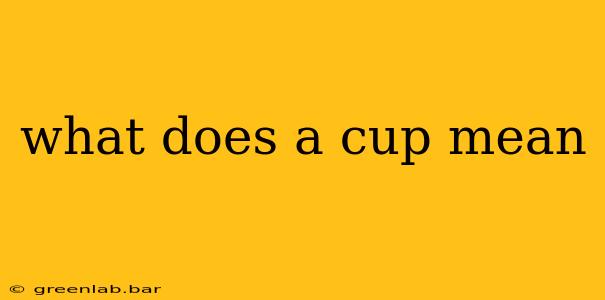Decoding the Meaning of "Cup": More Than Just a Vessel
The word "cup," seemingly simple, holds surprising depth and multifaceted meanings depending on context. While its most basic definition refers to a small, open container used for drinking, its significance extends far beyond the physical object itself. Let's explore the various ways "cup" is used and understood.
The Literal Meaning: A Drinking Vessel
At its core, a cup is a concave container, typically made of ceramic, glass, plastic, or metal, designed to hold and consume liquids. This is the most straightforward and widely understood meaning. Think of your morning coffee in your favorite mug, a child's juice box, or a celebratory champagne flute – these are all examples of cups in their literal sense. Variations in size, material, and design differentiate these vessels, but the fundamental purpose remains consistent.
Figurative Meanings and Symbolism:
The symbolism associated with "cup" transcends its practical use and frequently appears in literature, religion, and everyday speech. Here are some key figurative interpretations:
-
A Portion or Amount: We often use "cup" to quantify something, such as "a cup of sugar" or "a cup of tea." In this context, it represents a specific measured amount rather than a specific container.
-
Fate or Destiny: In religious and spiritual contexts, the "cup" can symbolize suffering or hardship one must endure. The phrase "drink from the cup" often implies facing difficult challenges and accepting one's fate. This usage carries heavy weight and evokes a sense of inevitability.
-
Abundance or Blessing: Conversely, a "cup overflowing" often signifies abundance, prosperity, and divine favor. This symbolic meaning represents blessings and a life filled with positivity.
-
Social Gathering or Event: The phrase "cup of coffee" or "cup of tea" can also represent a casual social meeting or encounter. It signifies a moment of connection and shared experience, going beyond the simple act of drinking.
Cultural Significance:
The cup's significance varies across cultures. In some cultures, specific types of cups hold ceremonial or ritualistic importance. The shape, material, and decoration of a cup can often indicate social status, religious affiliation, or cultural heritage. Therefore, understanding the cultural context is crucial for a full comprehension of its symbolic meaning.
Conclusion: A Multifaceted Symbol
The word "cup" proves remarkably versatile. Its meaning shifts depending on the context, ranging from a simple drinking vessel to a powerful symbol of fate, abundance, and social interaction. By understanding these nuances, we gain a deeper appreciation for the rich tapestry of meaning embedded within this seemingly commonplace word. Whether you're enjoying a morning coffee or pondering the weight of fate, the "cup" offers a fascinating lens through which to explore language, culture, and symbolism.

